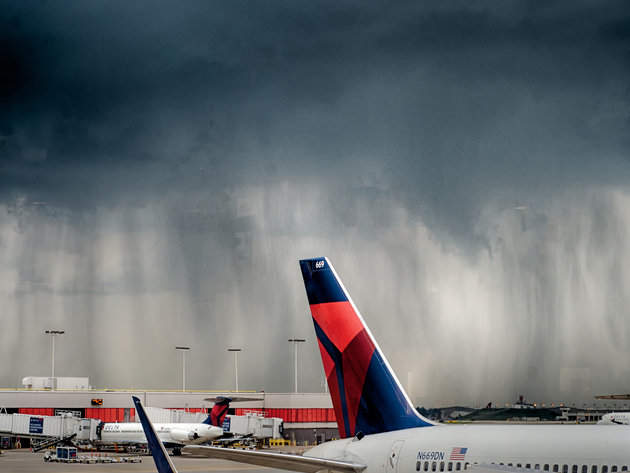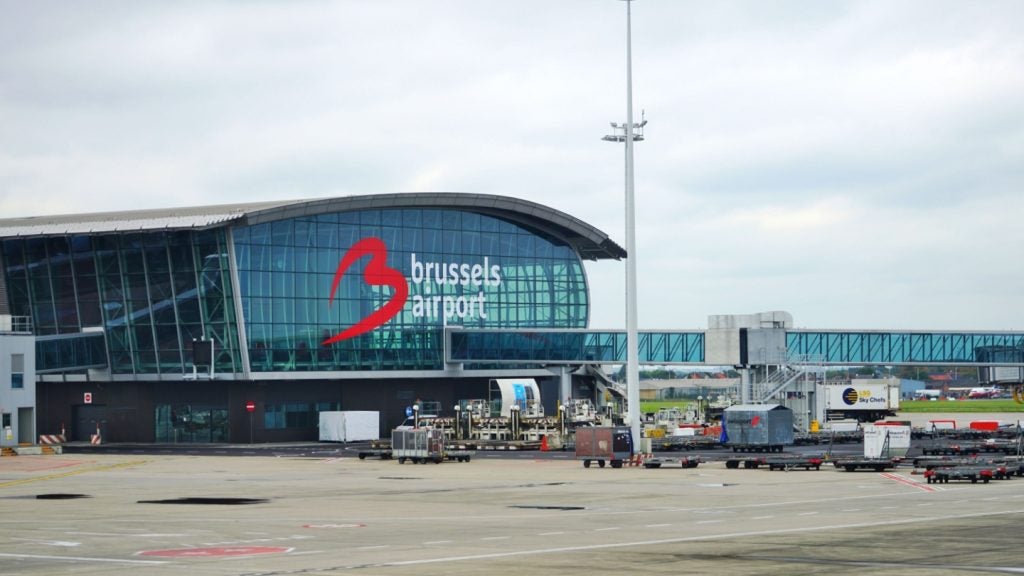
One of the long-standing challenges to the aviation industry, extreme weather continues to cause thousands of delays and cancellations each year and in some rare cases, it can even lead to serious accidents.
Recently, inaccurate weather forecasts were found to be partly responsible for a Virgin Australia jet making a last-ditch attempt at an emergency landing, terrifying passengers.
In India, a group of airlines joined forces to urge the Civil Aviation Ministry to put in place a mechanism that would provide weather updates “well in advance”, after over 20 flights to Delhi airport were delayed and diverted.
Overall, weather prediction has become much more accurate over the past 15 years. Data from the Bureau of Transportation Statistics shows that weather accounted for 32% of delays at US airports in 2015, down from 50% in 2003.
The trend is set to continue. An International Air Transport Association (IATA) report shows that global airline industry revenue is on the rise, with an expected jump of 12% in 2016.
Lower oil prices and rising demand for air services will mean that the industry is expected to generate profits of $39.4bn (£27.3bn) this year, compared to $35.3bn in 2015.
At least part of this revenue is expected to go into weather predictive technologies and improved operations.
The different types of predictive analysis
Long-range aviation weather forecasts have become more accurate with the advent of technology over the past decade, as well as more accessible to operators and pilots via computer screens or tablets.
How well do you really know your competitors?
Access the most comprehensive Company Profiles on the market, powered by GlobalData. Save hours of research. Gain competitive edge.

Thank you!
Your download email will arrive shortly
Not ready to buy yet? Download a free sample
We are confident about the unique quality of our Company Profiles. However, we want you to make the most beneficial decision for your business, so we offer a free sample that you can download by submitting the below form
By GlobalDataToday, long-range forecasts cover three to five days in advance over any region in the world, but the most accurate predictions come out of the inter-tropical convergence zones. They help operators determine the main and alternative routes, as well as any possible over-flight permit requirements if a re-route is needed.
“Having an accurate long-range forecast enables operators to shorten flight routing, avoid areas of turbulence, and limit exposure to adverse weather conditions,” writes Dave Houle, long-range forecaster at Universal Weather & Aviation in a blog post.
“Knowing upper wind and general weather conditions assists in determining best route, turbulence avoidance, technical stops, and required fuel load.”
Similarly, writing about three types of airport analytics, operations research manager at The Weather Company, Dr Alex Huang differentiates from descriptive, predictive and prescriptive analytics.
According to Dr Huang, descriptive analytics provide fairly superficial information about current weather conditions, such as the direction of the wind: “Much of this information is at our fingertips today and does not provide much insight to decision makers on future actions.”
On the other hand, predictive analytics “organize and then predict the outcomes by recognizing the patterns and impacts of future airport operations,” he explains. This configuration of data helps predict runway delays within given timeframes and it generally has “a significant impact on the efficiency of operations”.
Mitigating such disruptions comes down to prescriptive analytics, which combine optimization, risk assessment and cost modelling to individual airlines.
Powerful weather forecasting tools
Nowadays, aviation operators have an array of powerful predictive tools at their disposal.
Recognising that “weather is one of the greatest hazards to aviation”, the MET Office Aviation Services advises all sectors of the industry – from airlines, airports, air traffic control and management, ground handling, airport construction and maintenance.
Its OpenRunway platform is an online weather forecasting package which offers airport-specific hourly summaries of current and forecast weather up to five days in advance, detailed graphs of conditions and a map visualisation with satellite and weather radar overlays.
Another MET Office tool aimed at flight operators and dispatchers, ClearFlight uses clear global map viewing and monitors weather conditions across the world. The system highlights potential problems ahead and thus enables smart rerouting solutions.
In 2015, a five-year contract between MET and Heathrow Airport saw the first batch of on-site meteorologists delivered to a non-military organisation in the UK. In February 2016, easyJet began its own five-year partnership with the weather forecaster.
In the US, a new weather software programme developed by NASA has been in use by American Airlines for over two years.
The Dynamic Weather Routes System analyses current weather conditions and the flight’s trajectory, finding re-routes that are more efficient than the original flight plan. The system was found to save approximately 636 litres of fuel per flight and more than 1.3 tonnes of CO2.
Similarly, collaboration between the Federal Aviation Association (FAA), the National Oceanic and Atmospheric Administration (NOAA) and NASA led to the development of the NextGen Weather Program, which provides tailored weather prediction by “harnessing massive computing power, unprecedented advances in numerical weather forecasting, translation of weather information into airspace constraints, and modernized information management services”.
Automatic rebooking keeps passengers ahead of the game
Taking a different approach to weather forecasting, IBM launched Deep Thunder, a platform whose goal is to help airlines save money from fuel costs.
Although based on traditional weather forecasting methods, the platform will anticipate future congestion and traffic problems in airports, helping airlines to optimise their fuel load and thus reduce their costs.
Deep Thunder also predicts how future changes in temperature, precipitation, wind and other conditions can impact areas such as consumer buying patterns to business supply chains.
But the information gained from accurate weather forecasting is also being used to empower passengers.
Heading a “fast rebooking” trend, US airlines such as Delta, Southwest and United have each launched their individual rebooking systems, in an effort to reduce wait times and missed connections due to bad weather.
For example, in 2015 Delta launched its Viper Rebook Me system, which redirects “tens of thousands” of passengers who would otherwise have been left stranded for hours. According to the Washington Post, the airline claims that Viper managed to cut down on bad weather delays from 15 hours to anywhere between two to nine hours.
A similar platform was unveiled by Southwest. Its Baker app now makes the formerly long, drawn-out manual rebooking process automatic, reducing both cancellations and operating times.
This new rebooking approach even received songs of praise.
In April 2016, United’s own system picked up on a large Wartburg College choir group travelling from Minneapolis to San Antonio, which was delayed due to a snowstorm in Denver. The new system redirected the group to their destination via Minnesota, and an appreciation performance from the choir was soon uploaded to YouTube.
Continual development of weather forecasting solutions and technologies is paramount if airports are to cope with the rising passenger demand.
Statistics from IATA predict a 4% annual average growth in global air passenger journeys over the next 20 years. That means that by 2034, there will be double the number of air passenger journeys made today.
With that level of demand, congestion and delays are almost unthinkable – and even though weather cannot be controlled, the aviation industry is certainly finding new ways to predict, contain and minimise its effects to ensure a smooth ride ahead.





